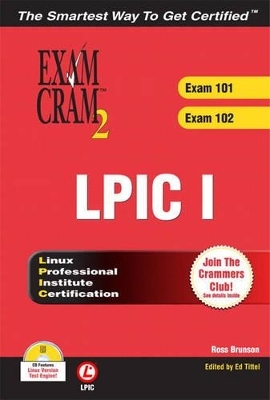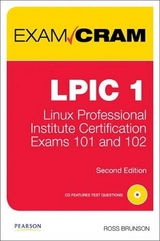
LPIC I Exam Cram 2
Pearson IT Certification
978-0-7897-3127-2 (ISBN)
- Titel ist leider vergriffen;
keine Neuauflage - Artikel merken
The Exam Cram 2 series from Que Publishing is the smartest, most efficient way for IT professionals to pass a variety of IT exams and become certified. The growing list of certifications covered by Exam Cram 2 now includes Linux Professional Institute Certification Exams 101 and 102. LPIC 1 Exam Cram 2 includes the most up-to-date exam information available. A CD is included and features ExamSim, an innovative exam simulator designed specifically for Linux users featuring randomly chosen questions with each practice session, Training Mode with answer button and Exam Mode with running timer. LPIC 1 Exam Cram 2 is a winning strategy to help you pass the exam the first time.
Ross Brunson is currently the director of Linux/Unix education for The Training Camp and an LPI-US (Linux Professional Institute) board member. He began his IT career in the U.S. Army in the 1980s working with battlefield simulation systems running on Unix platforms. Prior to joining The Training Camp, Ross authored several books about Unix/Linux integration with Windows, including The Linux and Windows 2000 Integration Toolkit. Ross began his formal training and consulting career with Learning Tree International as a courseware technical editor and was his area's second-highest scoring instructor. After a number of years conducting TCP/IP, Unix, Linux, and networking courses for Learning Tree, Mastering Computers of Scottsdale and other companies, he took a courseware and development position at Computer Associates developing and delivering Windows 2000 and Linux courses for many U.S. and international companies. Ross then took a position with Thomson Learning's Sair Linux certification and courseware division as the director of courseware development and instruction. He built an excellent instructor force spanning 13 countries and 110 instructors in little over a year, delivering many T3 (trainer preparation courses) to current and prospective instructors in the United States and overseas.
Introduction.
Self-Assessment.
I. LPIC Exam.
1. Linux Installation.
Linux Distributions.
LPI Certification and Distributions.
Which Version of Red Hat and Debian to Use?
Preparing Hardware for Installation.
Problem Peripherals.
Resolving Conflicts.
Viewing Configuration Addresses.
Partitioning Disks.
Performance.
Integrity.
Backup.
Security.
Understanding Partition Limitations.
Partitioning Applications.
Red Hat Installation Console Options.
Creating Installation Disks.
Boot Loaders.
LILO–The Linux Loader.
Grand Unified Boot Loader.
Viewing Boot Messages.
Exam Prep Questions.
2. Using the Linux Shell.
Understanding Shells.
Global and User Settings.
A Login Shell Session.
A Non-Login Shell Session.
Using the Command Line.
Structuring Commands.
Breaking Long Command Lines.
Command Completion.
Special Characters in the Shell.
Controlling Command Execution.
Possible Exit Statuses.
Executing Multiple Commands.
The Readline Library.
Command Substitution.
bash’s History Feature.
Important History Variables.
The fc Command.
Environment Variables and Settings.
The Path.
Getting $HOME.
Configuring Prompts.
Configuring the Prompt Step by Step.
Setting Options in bash.
Important bash Options.
Job Control.
Elements of Job Control.
Managing Processes.
Sending Signals to Processes.
Managing Process Priorities.
Exam Prep Questions.
3. Basic vi Skills.
Editors.
Modes in vi.
Editing in vi.
The Message Line.
Opening a File for Editing.
Navigating Within a File.
Force Multipliers.
Undo Operations.
Quitting Files.
Saving Files.
Command Mode Editing.
Inserting and Adding Text.
Changing or Replacing Text.
Deleting Text and Lines.
The Cut, Copy, and Paste Commands.
Named and Unnamed Buffers.
Searching in vi.
Searching and Replacing.
Fuzzy Searches.
Options in vi.
Advanced vi.
Running External Commands in vi.
Joining Lines.
Split Windows.
Exam Prep Questions.
4. Hardware.
Hardware.
IRQs and Ports.
Printer Ports.
Modems.
UARTs.
Using the setserial Command.
Ethernet/NIC Devices.
Configuring NICs.
The ARP Cache.
Point to Point Protocol.
Using Chat to Connect.
The PPP Daemon.
Authentication Options.
Plug and Play.
PnP Tools.
Configuring Sound and Time.
Local System Time.
The date Command.
The hwclock Command.
USB Devices.
Controller Types.
USB Devices and Linux.
USB and Storage Devices.
Using usbmgr.
USB Devices and Drivers.
Setting Up SCSI.
Exam Prep Questions.
5. Partitioning and File Systems.
Overview.
Partitions.
Swap.
Drive Partitioning Schemes.
Disk Partitioning Tools.
fdisk.
DiskDruid.
cfdisk.
Overview of File Systems.
Superblocks.
Inodes and Files.
Inodes and Disk Space.
File System Types.
Creating File Systems.
The mkfs Command.
File System Creation Options.
Advanced File System Commands.
File System Checker.
Tuning File Systems.
Debugging File Systems.
Mounting and Unmounting.
The File System Table.
Manually Mounting File Systems.
Automatically Mounting File Systems.
Unmounting File Systems.
Space Utilization.
Using du.
Using df.
Exam Prep Questions.
6. File Systems and Commands.
File System Overview .
What Belongs Where.
The Root of the System.
Oddities in the FHS.
Where Programs Live.
File Management Commands.
Tips for Working with Linux Files.
Basic Navigation.
Advanced Navigation.
Listing Files and Directories.
Determining File Types.
Touching Files.
Copying Files and Directories.
Moving Objects.
Transforming Data Formats.
Creating and Removing Directories.
Removing Objects.
Where Are Those Files?
Locating Files with locate.
Finding Files.
Which Command Will Run?
Researching a Command.
Linking Files.
Symbolic Links.
Hard Links.
Working with Permissions.
Permission Trio Bits.
Manipulating Permissions.
User and Group Ownership.
Changing Ownership.
Changing Group Ownership.
Special File Permissions.
Finding Files by Permission.
Default Permissions.
Using Disk Quotas.
Quota Commands and Files.
Quota Concepts.
Configuring Quotas.
Hard and Soft Limits.
Setting the Grace Period.
Getting Quota Information.
File Attributes.
Exam Prep Questions.
7. XFree86 Configuration and Troubleshooting.
Quick Overview of X.
How X Works.
Window Managers
Linux Desktops.
The XFree86 System.
Installing XFree86.
XFree86 Versions.
The XFree86 Configuration File.
Important XF86Config Sections.
Configuring xf86config.
Starting X.
X Customization Files.
Fonts in X.
X Display Manager.
Tuning X.
Into and Out of X.
Remote Clients.
Displaying X Clients.
Exam Prep Questions.
8. Text Processing.
Unix/Linux Toolset Mentality.
Working with I/O Streams.
Redirection of Streams.
Redirecting Standard Input.
Redirecting Standard Output.
Redirecting Standard Error.
Redirection Redux.
Pipes.
Filters.
Sorting.
Numbering Lines.
Counting.
Tabs.
Cutting Columns.
Pasting and Joining.
Unique Data.
Heads or Tails?
Splitting Files.
When cat Goes Backward.
Viewing Binary Files Safely.
Formatting Commands.
Translating Files.
He sed, She sed.
Getting a grep.
Examples of Using grep.
Using Regular Expressions and grep.
Exam Prep Questions.
9. Software Installation.
Important Exam Information.
Methods of Managing Software Installation.
Installing Software from Source.
The Makefile.
Example of a Compilation of Source Code.
Shared Libraries.
Determining Required Libraries.
Installing Software with Packages.
Red Hat Package Management.
The RPM Database.
RPM Package Files.
Package Name Conventions.
The rpm Command.
Validation of Packages.
Installation of Packages.
Verifying a Package’s Integrity.
Freshening Versus Upgrading.
Removing Packages.
Querying Packages.
Building RPMs.
What Happens in a Build?
Exam Prep Questions.
I. LPIC EXAM.
10. Linux Boot Process and Runlevels.
The Linux Boot Process.
Understanding Runlevels and init.
Shutting Down a System.
The init Process.
The /etc/inittab File.
Trapping Ctrl+Alt+Delete.
The Runlevel Directories.
Configuring the Runlevels.
Single User Mode.
Making Boot/Rescue Disks.
Exam Prep Questions.
11. Using Linux and GNU Documentation.
The man Pages.
The man Page Sections.
What’s in a man Page.
Where man Pages Live.
Using the man Command.
man Configuration and Path.
Action Keys in man.
Getting More Out of man.
whatis Apropos?
Additional Documentation.
Web and Third-Party Documentation.
The Linux Documentation Project.
Usenet Resources.
Communicating with Users.
The Issue Files.
Message of the Day.
Writing to Users.
Talking to Users.
Exam Prep Questions.
12. Managing Users and Groups.
The Importance of User and Group Management.
How the Kernel Understands Users and Groups.
What Accounts Are What?
Junior Sysadmins.
Normal User Accounts.
User Entries in /etc/passwd.
Special Login Files.
What Groups Are What?
Group Entries in /etc/group.
Group Passwords.
Adding Users and Groups.
Adding Users with useradd.
The useradd Defaults.
Adding Groups with groupadd.
Modifying Users and Groups.
Modifying User Accounts with usermod.
Modifying Groups with groupmod.
Removing Users and Groups.
Removing Users.
Removing Groups.
The Shadow Suite.
Encrypted Passwords and Shadow Fields.
shadow File Permissions.
Password Conversion.
Changing Passwords.
Aging Passwords.
skel Templates.
User Variables.
Exam Prep Questions.
13. System Administration.
Managing System Services.
Controlling Your Daemons.
System Logging.
Types of Logging.
Default System Log File.
Facilities and Priorities.
Putting It All Together.
Security Log Files.
Scheduling and Running Tasks.
The at Command.
The batch Command.
Using cron to Schedule Tasks.
cron Components.
Managing cron’s Job Tables.
Submitting a cron Job.
Controlling User Access to cron.
Archiving and Backing Up.
Planning a Backup Scenario.
Backup Commands.
Using cpio.
Using tar.
Other Compression Utilities.
Maintaining System Time.
NTP Files and Programs.
Exam Prep Questions.
14. Kernel Configuration and Custom Compilation.
Overview of the Kernel.
The Kernel Versions.
Monolithic Versus Modular Kernels.
Modules.
Module Dependencies.
Viewing Your Modules.
Loading and Unloading Modules.
Using modprobe to Manage Modules.
Patching the Kernel.
Using the patch Command.
Getting Kernel Source Code.
Configuring the Kernel.
make menuconfig.
make xconfig.
Steps to Compile a Kernel.
Exam Prep Questions.
15. Linux Shells and Scripting.
Writing Scripts.
Writing a Simple Script.
Executing a Script.
Using Positional Parameters.
Testing for Conditions.
Having Users Make Variables.
Scripting Constructs.
if/else Statements.
The for Loop.
while and until Statements.
Customizing the Shell Environment.
Execution Precedence.
Environment Variables.
Creating Variables.
Exporting Variables.
Removing Variables.
Using Variables in Scripts.
Quoting and Variables.
How to Use Double Quotation Marks.
How to Use Single Quotation Marks.
Shell Aliases.
How Aliases Work.
Viewing, Setting, and Removing Aliases.
Examples of Using Aliases.
Shell Functions.
How a Function Works.
Viewing, Setting, and Removing Functions.
Understanding Shell Levels.
Exam Prep Questions.
16. Linux Printing.
Linux Printing Overview.
How lpd Printing Works.
The Printer Capabilities File.
Remote Printing Entries.
Printing Command Overview.
The lpd Daemon.
Print Filters.
Printing with lpr.
lpr Command Options.
Monitoring Print Jobs with lpq.
lpq Command Options.
Examples of Using lpq.
Removing Print Jobs with lprm.
lprm Command Options.
Examples of Using lprm.
Monitoring Print Jobs with lpc.
lpc Command-Line Options.
Internal lpc Options.
Examples of Using lpc.
Additional Printing Commands.
Printer Security.
Exam Prep Questions.
17. Basic Networking.
Conceptual Overview of Networking.
Necessary Configuration Information.
IPs.
Networks and Hosts.
Address Class Ranges.
Using the Bits to Determine Class.
Network Masks.
Using Default Network Masks.
Gateway Addresses, or “Do I Dial 9?”.
Broadcast Addresses.
Custom Network Masks.
Determining a Custom Network Mask.
Scenario 1: Custom Subnetting from Scratch.
Scenario 2: How Many Hosts on a Network?
Managing Interfaces.
Viewing IP Information.
Red Hat Interface Configuration.
Debian Interface Configuration.
Viewing and Configuring Gateway Addresses.
Local Name Configuration.
Network Configuration Utilities.
Network Utility Examples.
Exam Prep Questions.
18. Network Services.
Network Services.
Providing Services on Demand.
Using inetd and xinetd.
Using TCP Wrappers for Securing Services.
inetd and TCP Wrappers.
xinetd and TCP Wrappers.
The hosts.allow and hosts.deny Files.
Format of hosts.allow and hosts.deny.
Using Rule Options.
sendmail, Bloody sendmail.
sendmail Configuration Files.
The sendmail.cf File.
Aliasing and Forwarding Mail.
sendmail-Related Utilities.
Apache.
How Apache Runs.
Using apachectl.
Apache Configuration Files.
Apache Directives.
Network File System.
NFS Daemons.
Exporting File Systems.
Samba.
Samba’s Configuration File.
Important smb.conf Entries.
Setting Up a Simple Samba Server.
Samba Client Connections.
Domain Name System.
Components of DNS.
Types of DNS Servers.
The named.* Files.
Zone and Record Types.
Exam Prep Questions.
19. Security.
Using TCP Wrappers to Secure a Service.
Allow and Deny Files.
Understanding Permission Problems.
Finding Files by Permissions.
Validating Package Integrity.
Validation Methods.
Secure Shell.
SSH Components.
Using SSH Client Utilities.
Using SSH Sans Password Prompts.
Using Firewalls for Security.
Understanding Basic iptables.
iptables’s Three Chains.
Using the iptables Command.
Configuring an iptables Chain.
Exam Prep Questions.
20. Practice Exam 101.
21. Answer Key 101.
22. Practice Exam 102.
23. Answer Key 102.
Appendix A: Debian Package Management.
Appendix B: What’s on the CD-ROM.
Glossary.
Index.
| Erscheint lt. Verlag | 7.10.2004 |
|---|---|
| Verlagsort | Upper Saddle River |
| Sprache | englisch |
| Maße | 152 x 226 mm |
| Gewicht | 888 g |
| Themenwelt | Mathematik / Informatik ► Informatik ► Betriebssysteme / Server |
| ISBN-10 | 0-7897-3127-4 / 0789731274 |
| ISBN-13 | 978-0-7897-3127-2 / 9780789731272 |
| Zustand | Neuware |
| Haben Sie eine Frage zum Produkt? |
